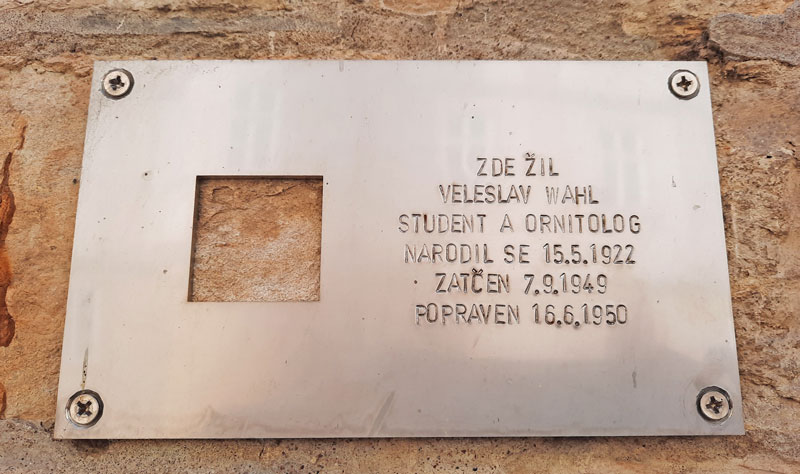Last Address Memorials
If you enjoyed reading the story behind the Prague Stumble Stones then you might also be inspired by another growing international memorial to look out for called the Last Address. Whereas the Stumble Stones are embedded in the ground outside the last freely chosen address of a person before being deported in World War Two, the Last Address plaques are on the walls at eye-level and mark the final registered address of a person who suffered political repression and death. In Czech it relates directly to repression by the Communist Party during the Soviet occupation 1948-1989. The Last Address project in Russia can commemorate people going as far back as 1917.

Like the Stumble Stones the language on the plaque will be the national language and there will be information relating to that person. As well as the date of birth and profession, in Czech you’ll see “Zatčen” which tells you the date of arrest. You’ll see “Popraven” which tells you the date of execution. Some countries also include a date of rehabilitation. How do you rehabilitate somebody who is already dead? Well in these cases it means that the charge against them was rescinded and they were in effect, pardoned. More about that at the end of the post.
The biggest difference between the projects is that Stumble Stones go in the ground so you need the permission of the city whereas Last Address plaques go on the wall so you need the permission of the building owner.
Origins
It’s not just like the Stumble Stones project, the Last Address project was actually inspired by that project. Although there are a group of people involved including human rights activists and historians the person most associated with the launch of the Last Address initiative is journalist and civic rights campaigner Sergey Parkhomenko. It was his inspiration by the Stumble Stones project which made him engage a famous Moscow architect called Alexander Brodsky to create the design for the plaque.
The Last Address Plaque
The stainless steel plaque always measures 19cm x 11cm with the text on the right and the cut out square on the left. In Prague I’ve heard this cut out square described as being like a missing cobble in the pavement i.e. like a person removed from the community. I like that description but in reality it represents the lost image of the person, erased from history. These things are notoriously difficult to see even at eye-level. You’ll think it’s an address plate or a company logo etc. They’ve been installed in Prague since 2019.
Veleslav Wahl
Just in case you looked carefully at the picture above and you are interested why a Student and Ornitolog (Expert on Birds) got caught up in this then read on.
The bird reference comes from the fact that during WW2 he worked as a researcher on birds at Prague Zoo and at the same time was a member of the Czech Resistance (he received two awards for bravery including the Czechoslovak Military Cross). He was lucky to be alive in any case because his father and an uncle had been executed by Nazis in the aftermath of Operation Anthropoid.
Post-war he married and began to get involved in Socialist politics. It was shortly after this in 1947 that he formed a relationship with an American diplomat and a year later after the 1948 Communist Coup he began to collect intelligence for the USA hence why he was arrested and executed (his wife served 11 years in prison).
For any Czechs involved in the Last Address project you’ll often find reference to Act 119/90. This was called the “Judicial Rehabilitation Act” (it was the 119th law passed in 1990) and it cancelled most of the judicial decisions made between February 25th 1948 (the Communist coup) and January 1st 1990 (the post-Communist Vaclav Havel government).
At the time of writing the Wilson Center has an interview with Sergey Parkhomenko where he describes the Last Address project goals.
Something Related or a Few Minutes Away
Memorial – Prague Stumble Stones Project
History/Communism – 1948 Communist Coup
History/WW2 – The Beneš Decrees
Famous Czechs – Milada Horákova
Famous Czechs – President Klement Gottwald
